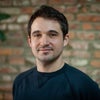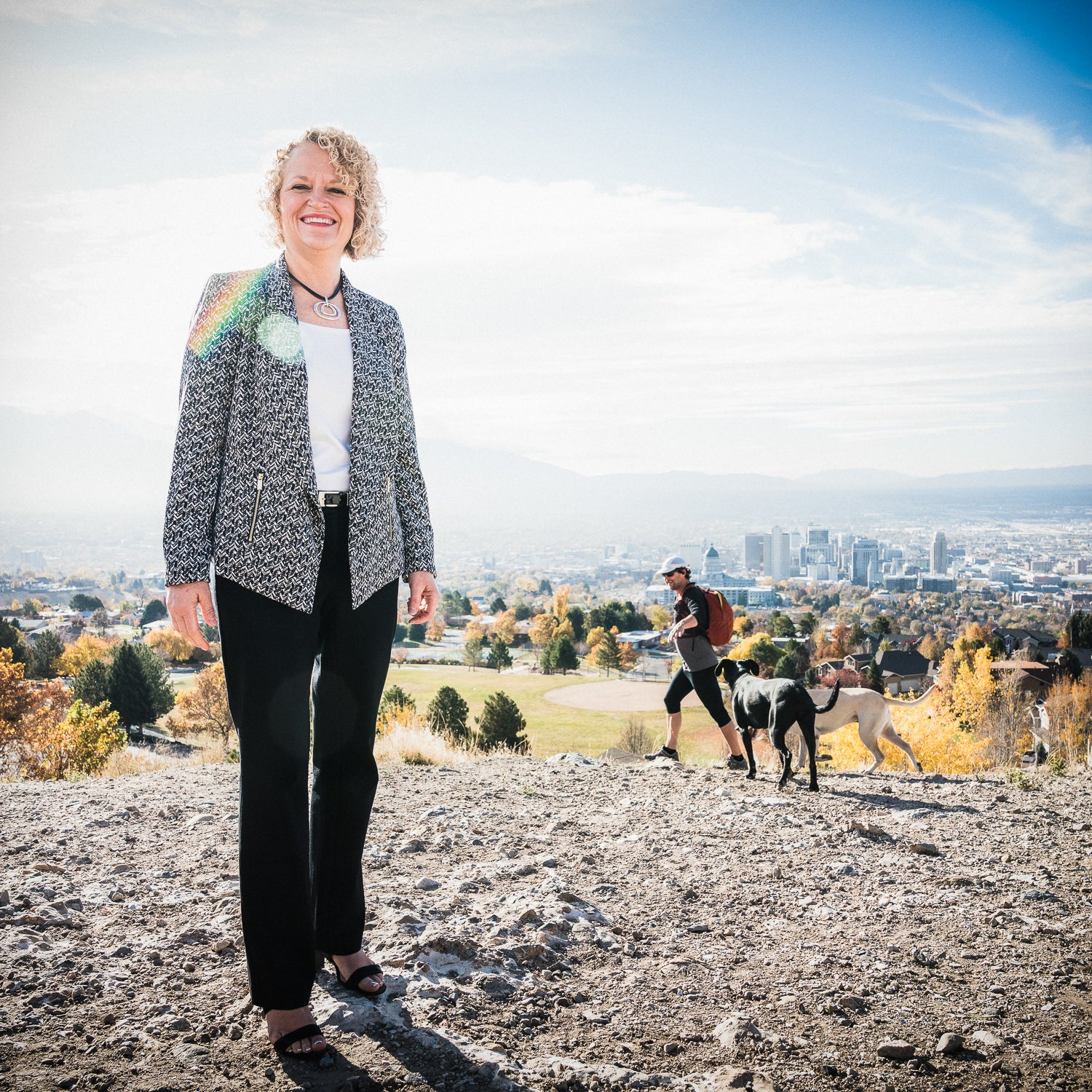Jackie Biskupski, the tenacious, curly-haired , breezes into the lobby at the Hotel Monaco, plops onto a plush leather couch, and after a very brief introduction, immediately makes apparent her most pressing concern.
“Climate change is messing with my ski season,” she says, leaning forward with intensity. Precipitation, even in Utah’s high Wasatch mountains, has been uneven of late. And precipitation means everything—not just for Utah’s skiers but for Salt Lake City itself. If the snow goes away, the city’s water supply goes with it.
The 51-year-old Democrat mayor of the largest city in one of the most conservative states in the nation understands the peril that the climate crisis poses. Indeed, for her—a Minnesota transplant drawn to this region more than 20 years ago to ski these towering peaks—it’s personal. And the personal is political, especially when you run an enormous metropolis.
Biskupski—a progressive, a lesbian, and one of only a handful of high-powered women in Utah politics—has emerged as a state and national climate leader since she was sworn into office in 2016. She is one of a cohort of outspoken local politicians around the nation rushing to surrounding issues from women’s rights to environmental protection. In June, Biskupski joined scores of other mayors across the country after the White House announced that it would pull out of the agreement. She was also a key player in convincing the U.S. Conference of Mayors to adopt a resolution by 2035. Salt Lake City made in the summer of 2016, helping catapult Biskupski to national prominence.
She has also contended with some serious struggles right here in her own backyard. Over the summer, Salt Lake City reluctantly said goodbye to Outdoor Retailer, the country’s premier outdoor-recreation-industry trade show, after the state government’s vigorous industry-backed assault on public lands drove the expo from town. And earlier this month, President Trump stood on a stage in Utah’s State Capitol and announced to a gloating crowd of politicians and conservative activists that he would downsize Utah’s Bears Ears and Grand Staircase–Escalante national monuments by 85 and 50 percent, respectively. Biskupski was not around to welcome the president, but she did his way: “Things @realdonaldtrump should help reduce 90 percent other than public lands: carbon emissions, student debt, school-to-prison pipeline, medical costs….”
When her city’s image, economy, and well-being are at stake, Mayor Biskupski will stand up to anyone, even the president.
The mayor’s black boots click and her leather jacket hangs off her back as she strolls through the lobby of the Hotel Monaco, hops the elevator, and emerges in a second-floor conference room. She’s here to address a group of environmental nonprofit leaders who have traveled from across the country to hear her plan to transition Salt Lake City to clean and renewable energy. And when she takes the podium, she gives them what they came for: She speaks of the devastation of climate change. She speaks of the city’s investments in solar farms, electric vehicles, and green buildings. She speaks of her desire to reduce local carbon emissions by 80 percent by 2040.
The president and his administration “chose to turn their backs on the world and ignore science,” she concludes with a nasal Midwestern twang. “But cities will not be deterred, nor will we turn our backs.”
And then she’s done, back through the elevator and out the hotel door. She climbs into the passenger seat of her small silver Subaru, tells the driver to go, and we are on our way through the streets of the glittering and complicated city she leads. It’s a little after 9 A.M., and Jackie Biskupski is on the job.
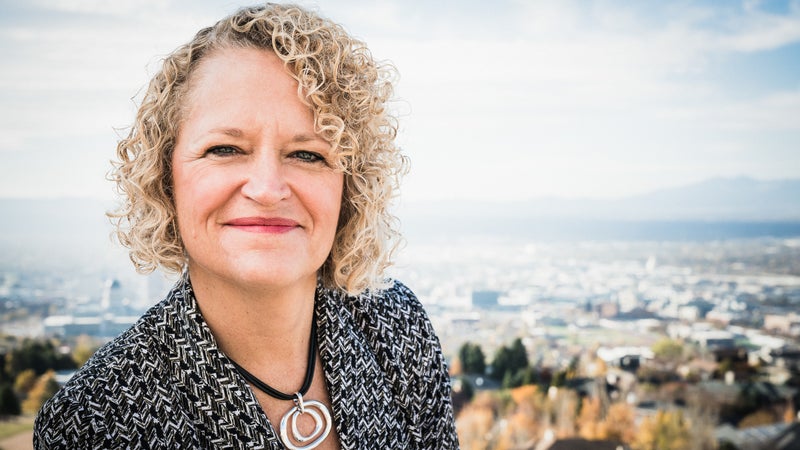
The mayor’s Subaru merges onto a broad boulevard and zips east toward the Wasatch Range. Biskupski relaxes in her seat while a burly man with a blond buzz cut and a slight limp sits behind the wheel. He’s her bodyguard. As a lesbian with a wife, two kids, and very left-leaning political views, she has received a number of threats over the years. “It’s heartbreaking,” she says.
Biskupski has long been a fixture in Utah politics. She came come to Utah in the 1980s to live close to the mountains, spending as much time as possible on the slopes while working in the city. It was during those youthful days that she fully realized she was gay. Despite the state’s conservative Mormon culture, she found in the city a tight community of fierce LGBTQ advocates. When local voters sent her to the legislature in 1998, she became the first openly gay person elected to state office in Utah’s 100-year history. When she became mayor in 2016, it was another milestone. She is the city’s first openly queer mayor, though not the first female and certainly not the first progressive to hold that role—Salt Lake City has elected Democrat mayors since 1976.
“Everything feels impossible here until you do it.”
Like many members of the queer community, Biskupski learned how to persevere in the face of sometimes scary adversity. On a broad, lightly-trafficked boulevard, our car passes within sight of East High School, the origin of Biskupski’s political career.
In the mid-nineties, kids at East High School tried to form the first gay-straight alliance in the state. They did it, the mayor says, “just to feel safe at school and to support one another and get through the day.” But the conservative school board and the state government freaked out, and the controversy consumed Utah. “They banned all [student] clubs for years,” she says, “and it to get the clubs back into our schools.” After that, Biskupski signed on to manage a campaign to unseat one of the incumbents who had supported the crackdown. When her candidate won, she was hooked. In 1996 she ran for the Salt Lake City Council and lost. Two years later, she ran for the state legislature and won. She has been in government service ever since, and says she always harbored ambitions to become mayor. “Everything feels impossible here,” she later tells me, “until you do it.”
In 2015, Biskupski ran as a pragmatic progressive on a platform that called for the creation of a city-level department of economic development, fast action to address the city’s affordable-housing shortage, and the protection of public lands and waters. Her opponent, Ralph Becker, was an unflashy two-term incumbent who also laid claim to the mantle of progressive politics. “It was two progressive individuals running against each other who probably agreed on the bigger picture of things but disagreed on how to get there,” says Matthew Rojas, Biskupski’s communications director. “It was about style. We said it was time for a mayor who is more accessible.”
In the end, by a little over 1,000 votes.
During her first year in office, Biskupski focused largely on local economic matters: crafting an affordable-housing master plan, planning four new—and —homelessness resource centers, and establishing an economic-development department. Then she began in earnest the arduous process of transitioning Salt Lake City away from fossil fuels. Less than six months after taking office, she subscribed the city to a solar farm in rural Utah. The idea, Biskupski says, was to both encourage sustainable energy generation and create new jobs in Utah’s countryside, where the decline of traditional employment in extractive industries has fueled anti-public-lands sentiment.
That summer the city made its historic pledge to power itself entirely on clean and renewable energy by 2032. Then, in September 2016, after a yearlong negotiation, the mayor announced with Rocky Mountain Power in which both parties promised to work together to develop clean-energy projects that will enable Salt Lake City to meet its ambitious goals. This put the city well ahead of large municipalities like Seattle and New York City, which have not yet made 100 percent clean-energy commitments much less plans to realize them.
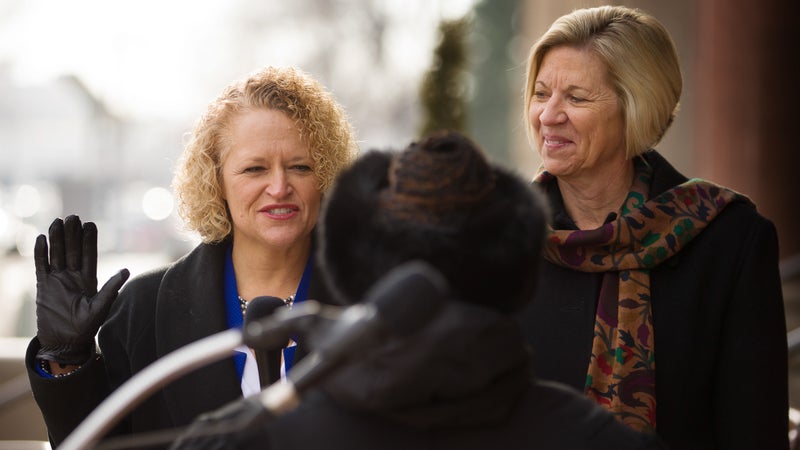
This bold, deliberate approach is quintessential Biskupski. “I wouldn’t call her a shrinking violet by any means,” says Mike Noel, a Republican state representative from Utah’s rural southwest. “She is very set in the things she believes and she has certain political issues that motivate her strongly, but she would listen, you know? We had our differences, but it was never to the point where you couldn’t discuss things with her.”
And then there is her work on the national level. As Jodie Van Horn, director of says, “Her leadership extends far beyond Salt Lake City.” She has rallied her colleagues in the U.S. Conference of Mayors to unanimously support a nationwide transition to clean and renewable energy, and recruited them to join Sierra Club’s Mayors for 100% Clean Energy initiative, of which she is a cochair.
“Nobody is waiting now for the federal government to do something,” Biskupski says. “We are leading the way. We have to.”
Biskupski’s Subaru continues through Salt Lake’s bustling weekday streets and passes beneath the long shadow of the state capitol building, a granite neoclassical behemoth that looms on a hill above the city. In recent years, that building has become the nerve center of Utah’s anti-conservation campaign, which has made national headlines, and served as the dark backdrop for all of Biskupski’s accomplishments.
Most notoriously, both Governor Gary Herbert and Utah’s congressional delegation, led by House Natural Resources Committee chairman Rob Bishop, have crusaded against the 111-year-old Antiquities Act, a foundational conservation law that enables the executive branch to independently establish national monuments on public lands.
In May, Utah’s powerful senator Orrin Hatch helped convince the Trump administration to launch its review of dozens of national monuments, eventually leading to this month’s decision on Bears Ears and Grand Staircase–Escalante national monuments. The mayor denounced the review straightaway: “Any federal decision to modify acreage or roll back protection of these incredible spaces,” she said , “will have negative and far-reaching impacts on Salt Lake City, as well as our entire state.”
One of those impacts arrived earlier this year, when several outdoor-gear companies lobbied to pull Outdoor Retailer from Salt Lake. For decades, the show brought thousands of people to the city to view new products from brands like REI, the North Face, and Patagonia, generating an annual $45 million for the region. But in February, the show that it was leaving Utah due to the state government’s relentless political assault on federal public lands. “It is a huge hit,” Biskupski says. “It is a huge hit for us.”
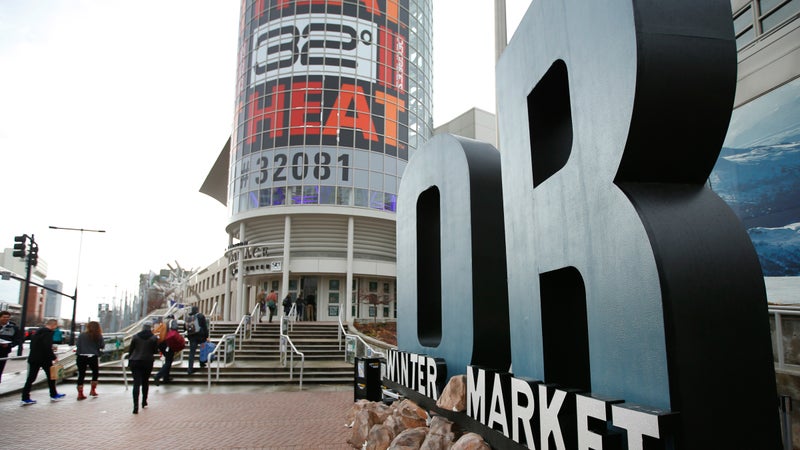
Despite the mayor’s behind-the-scenes attempts at negotiation and repeated pleas for it to stay, Outdoor Retailer decamped for Denver, Colorado, with its more public-lands-friendly politicians. While Biskupski understands the trade show’s motivations to relocate, she’s saddened by the move. “It is so hard,” she says. “Because they were mad at the state, yet the city really got punished. And I am on [the outdoor industry’s] side, you know?”
Against the backdrop of Utah’s state politics, her efforts were not enough. Indeed sometimes her accomplishments seem bite-size compared with the damage the state government has done. “In the end, our disagreement was with statewide policies and the policies of the congressional delegation, so there were limits to what the city of Salt Lake could do,” says Amy Roberts, the executive director of the Outdoor Industry Association. “Even if [Biskupski] had used her bully pulpit to the full extent, would it have changed the mind of the governor or congressman Rob Bishop? It seems unlikely.”
“The mayor [recognizes] the integral value of public lands, clean air, and clean water to Salt Lake City’s quality of life,” says Peter Metcalf, the former CEO of Salt Lake City–based Black Diamond, who worked with Biskupski , an effort to protect the Central Wasatch Mountains. “However, the state legislature and congressional delegation have done all they can to limit the mayor’s ability to effectively deal with many of these issues.”
Metcalf, who was instrumental in the negotiations to move Outdoor Retailer, also pointed to Biskupski’s inexperience at the time, with only one year on the job. “In my opinion, she [did not] have relationships with the governor or the congressional delegation that could have moved the needle.”
“Nobody is waiting now for the federal government to do something. We are leading the way. We have to.”
While Outdoor Retailer is gone for good, the fight is far from over. As Utah continues its attack on federal lands, the economic fallout from the trade show’s departure could still provide Biskupski with an opportunity to highlight the damage done by the state government’s policies, and could well have implications in the 2018 midterm elections and beyond. Indeed, exploiting this kind of leverage will be crucial if she has any hope of preventing the state and federal government from undermining her progress in protecting the region's vital ecosystems and decreasing carbon emissions.
The extent to which she can accomplish that remains to be seen, but Biskupski seems up to the task. “We lost what I would say is a big battle with Outdoor Retailer, but that doesn’t mean we just go away and tuck our tails,” she says. “It means we absolutely have to continue being that vocal minority, and even more so now.”
The mayor’s one-car motorcade climbs out of the city and into the dry foothills of the Wasatch Range. We have arrived at our destination: . Salt Lake City purchased this tract from the U.S. Forest Service last year in order to conduct studies into watershed management. It is a place where many of Biskupski’s most pressing concerns—public lands, outdoor recreation, and climate—converge.
We walk up the canyon as the sun inches above the mountains. Light catches the cottonwoods and the scrub oaks and sets them aglow. Sheer slopes of red sedimentary rock surround us on all sides. Leading the tour is Laura Briefer, the first female director of the city’s department of public utilities in its 150-year history. Publicly owned canyons like these, she explains, collect snowmelt from the high mountains and deliver it to the city’s ever expanding population. As much as 60 percent of Salt Lake’s drinking water comes from such Wasatch streams. But Briefer, a trail runner who knows these foothills intimately, says the future here is frighteningly uncertain. “Climate change, especially in the intermountain West, is manifested in the water system,” she says.
A 2013 study in the American Meteorological Society journal Earth Interactions, for instance, for every degree Fahrenheit of warming, the volume of water in the streams that feed Salt Lake City's watershed could decline by up to 6.5 percent. “It could really just turn the water system as we know it upside down,” says Briefer.
Ultimately, then, all of Biskupski’s rhetoric meets red-rock reality right here in in this narrow canyon. Biskupski stands before a freshwater reservoir as trout dimple its surface. In the hills above, where local hikers and trail runners traverse the ridges, a coyote crosses into view. This is the kind of healthy publicly owned landscape that drew the mayor to the American West in the first place. This is the kind of place she’s fighting for.
“Oh,” says Biskupski, with delight, “this is beautiful.”

